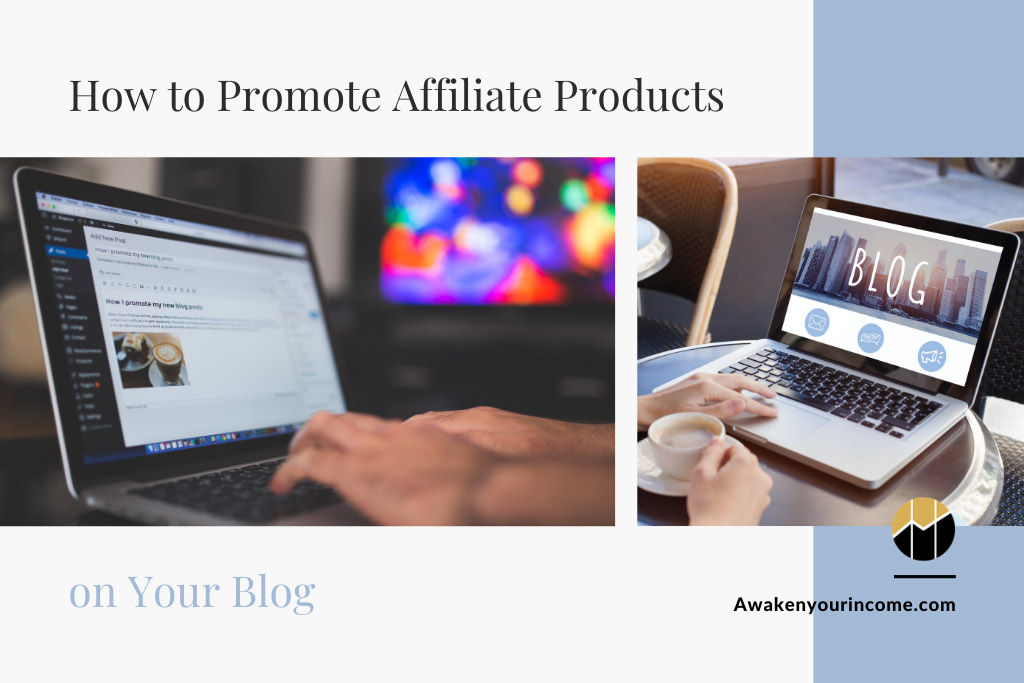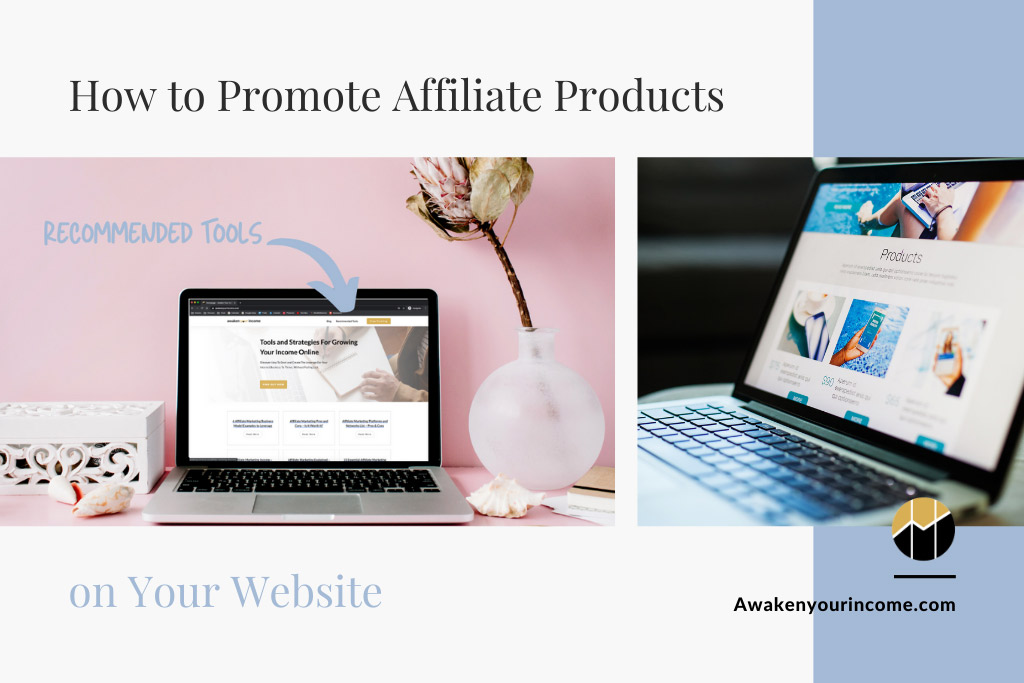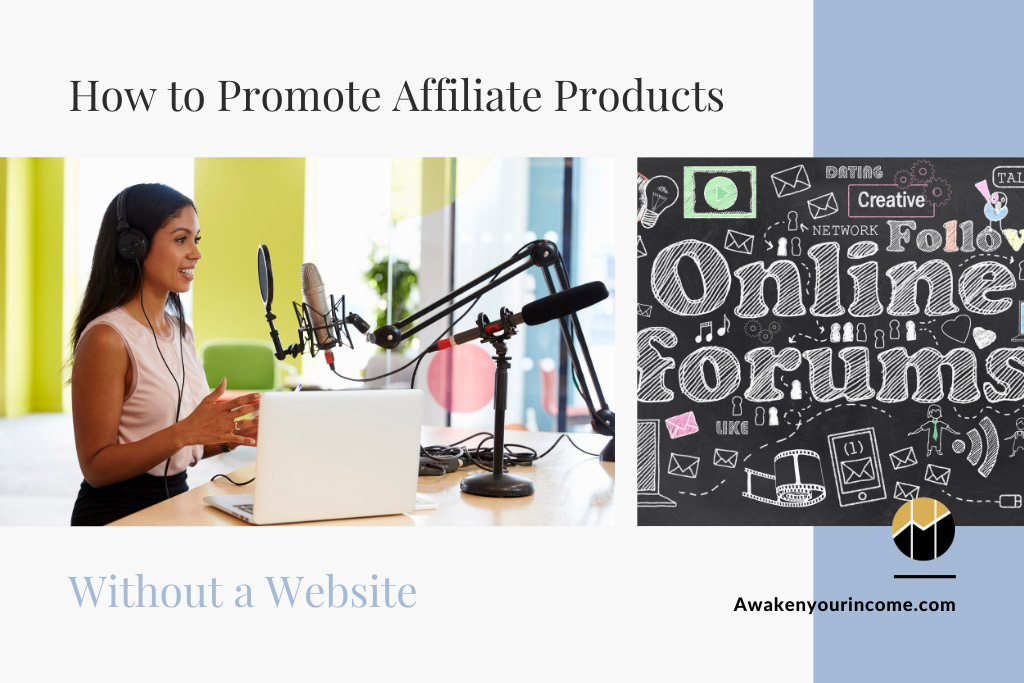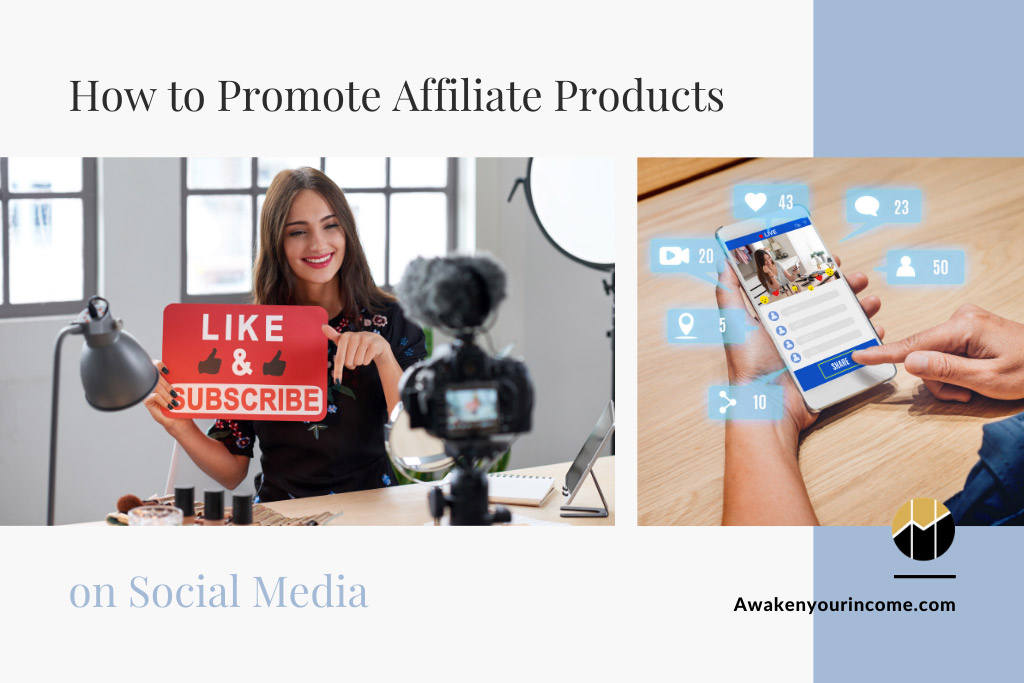Top affiliates marketers have a diverse affiliate marketing strategy. Also, these marketers know where to place their affiliate links to drive profitable results.
It’s rare that posting your links in one page, for instance, will drive enough traffic to product results.
Do you want to learn how to promote affiliate products that drive income?
Let’s dive into the ways you can promote your affiliate links in your blog, your site, on social media, or even without a website.
Getting Started With Promoting Affiliate Products
Before diving into the specific strategies on how to go about promoting affiliate products, you want to first make sure you’re setting yourself up for success.
Here are 3 things you want clarified before you begin promoting any affiliate product.
1. Establish the Affiliate Product and Strategy Correlation
First of all, what type of affiliate product are you promoting?
The strategies you use for promoting your affiliate links will depend on the type of product you are promoting:
- One-time purchase.
- A subscription.
- High-ticket product.
- Low-ticket item.
The marketing strategy you choose should be according to the type of product you are offering to your audience.
For instance, high-ticket offers are better sold via webinars, but low-ticket products are easily marketed via email.
What you offer and how you promote it influences your audience trust and buying intentions.
In the end, it all comes down to trust. The higher the levels of trust, the easier it is to promote high-ticket affiliate products.
Also, the higher the price, the longer you need to nourish and provide value to your audience in order to transition them from consumers to customers.
Start by determining what products you want to promote.
Check our Top 12 Affiliate Marketing Niches with Affiliate Programs blog post to get some ideas.
And if you are wondering… Where can I find affiliate products to promote in my niche?
Check out Affiliate Marketing Platforms and Networks List blog post.

2. Determine Which Platforms You Are Going to Leverage
After choosing the type of affiliate product you are going to be promoting, the next step is to decide what platforms are suitable for your promotions.
The core platforms for promoting affiliate products are:
- Your blog.
- Your website (includes resource pages, landing pages for opt-ins, etc.).
- Website alternatives (podcast and forums).
- Social Media (YouTube, Facebook, Instagram, Pinterest and Twitter).
Blog posts and YouTube videos are a great way to engage and provide value first to your audience, before putting an offer in front of them.
Think of it this way:
The more traffic you drive, the more conversion opportunities and the more affiliate sales you can make.
Insider Tip: Combine at least three to four strategies for your affiliate products instead of focusing on one. This will allow you to drive high enough volume and have multiple touch-points with your audience, in order to create the impact you want.

3. Choose Your Paid and Free Promotion Strategies
Most of the affiliate marketing strategies that I am going to run you through are free. But there are also a few paid methods, such as:
- Online advertising (Facebook ads, Google ads, etc).
- Solo ads.
Paid advertising is a highly effective and scalable way to promote affiliate products, as you can get results very quickly. But it takes skill, patience and the right mindset, otherwise you can easily feel like you’re flushing money down the drain when you don’t get the results you expect.
With that said…
Here’s how to promote affiliate products for free:
- Blog posts (how-to posts, reviews, product comparisons, etc.).
- Resources pages.
- Email marketing.
- Within your own products (eBooks, online courses).
- Free resources (webinar, course, cheatsheet).
- Banners on your website.
- Podcasts.
- Forums.
- Social media posts (Facebook, Instagram, Pinterest and Twitter).
- YouTube videos (tutorials).
Now, let’s dive into the core platforms for promoting affiliate products.

How to Promote Affiliate Products on Your Blog
Having a blog allows you to create a diverse range of blog posts that not only give value to your audience but also gives you the opportunity to promote to them by adding affiliate links in those blog posts.
Here are 4 tips on how to promote affiliate products on your blog:
1. Create a Tutorial or How to Post
Creating a product tutorial or a how-to post allows you to go step-by-step from problem to solution, which creates engagement with your audience.
Here are some examples:
- How to use the product for the first time.
- How to get better results with the product.
- How to order or buy the product.
- How to set up the product.
- 20 Things to know before using the product.
- Where to find the product.
- Insider product tips.
- Tips to be successful with the product.
2. Write an In-Depth Review Blog Post
Another option is to write an in-depth review of the product you are promoting, such as:
- Product review.
- Case study.
- The pros and cons of using the product.
- Examples of others who have been successful with the product.
A review not only introduces the product to your readers but also your opinion guides them in understanding why they should, or should not, be buying it.
When writing a review, here are a few things that you should always remember:
- Understand the company that you are promoting and the products or services they offer. This means that you get your hands on the product and test it i.e. use it yourself… be a customer of the product!
- Be honest and talk about the pros and the cons. Your audience will trust you more easily if they see that you are honest.
- Include product images and give all the useful information you have to offer about the product. If you can take the photos yourself, do it.
3. Publish a Product Comparison Post
Product comparison posts target consumers who are ready to buy and are looking to decide which option to go for. Write posts based on a buying-intent keyword.
Here are some ideas to talk about products:
- Product A vs Product B – a detailed comparison of the two leading products in the field.
- Product alternatives.
- Why I switched from Product A to Product B.
- Best [product name] (online).
- Best [product name] for [use case/audience].
- Best [product type] in (current year).
4. Weave Native Ads into List Posts
Another good way to include affiliate product links in your blog post is to write complimentary content that supports the idea and solutions of the suggested product.
This is what’s known as native ads – organically placed affiliate links in written content.
List posts are a great format for weaving in affiliate links in your content without being spammy.
Here are some examples of list posts:
- Top 5 Products for [benefit].
- 10 Tools I can’t live without.
- 25 Experts reveal the best tools for [action].

How to Promote Affiliate Products on Your Website
Your website is the face of your brand and an important part of your online presence.
Regardless if you have a blog or not, in this section I am going to go through some strategies that can be implemented alongside the blog strategies or on their own.
Here are 7 tips on how to promote affiliate products on your website:
1. Create a Resources or Tools Page
As part of your marketing strategy, create a resources page on your website highlighting the top tools and products you recommend.
On this page, list and discuss the products you regularly use and recommend.
Here are some examples of how this type of page can be named:
- Resources.
- Recommended Tools.
- Tools.
2. Build an Email List
Another key strategy in affiliate marketing is email marketing.
An email list is one of the most valuable and sustainable ways to build an audience or community.
Email marketing is also an important strategy for driving visitors to your website, distributing your content, promoting affiliate products and engaging with your audience.
You can start building your list with a newsletter opt-in or a lead magnet download (opt-in), for example.
Providing a sign-up button to your email newsletter is a way to start building a list of consumers who expect to hear from you and are happy when they do.
Once readers subscribe to your blog, you could send them an automated welcome email series.
In this series, build trust with your readers by telling your unique story. Then, provide value by sharing relevant articles (which can include affiliate links in them).
When you have an email list, you can use it to promote your links and special deals (coupons, discount, or seasonal product promotions) to them.
The best way to get people’s email addresses is to give something for free (known as a lead magnet).
In exchange for their email, they get a free download, such as:
- Ebook.
- Printable checklist.
- Cheatsheet.
- Etc.
More on these further down.
But, to implement email marketing successfully (with or without a website), you need an email marketing provider, i.e., an autoresponder software.
An email marketing software will allow you to:
- Create registration forms (added benefit).
- Send automatic emails (autoresponders).
- Broadcast to your list whenever you like.
- Keep track of people who viewed your emails and who clicked on your affiliate links.
Services such as AWeber are easy to use. You can read more about it on my resource page.

3. Bundle Affiliates With Your Own Digital Products
This is another form of native advertising.
If you have your own product, you could promote other affiliate products that complement yours. This could be a product, a service or a tool.
It also doesn’t feel salesy or forced because the solution you are offering is inside a solution-oriented product – your own product.
Examples of digital products that you can create include:
- Ebooks.
- Online courses.
- Tools.
- Plugins.
- Spreadsheets.
- Etc.
Naturally, these digital products provide perfect opportunities to embed your affiliate links.
4. Make Your Own Products Around the Affiliate Offer
This is very similar to the option above. The core difference is that this product will be free.
A lead magnet is a free resource that provides value and can act as an introduction to the affiliate product that you want to promote next.
Free resources, like a course, are a great way to offer value first, build your list, and promote to when it’s beneficial for the customer taking the course.
Alternatively, you can create a webinar (live or on-demand), which are one of the best ways to promote higher ticket offers.
In a nutshell, you can create a course around the affiliate or do a training webinar around the product.

5. Place Affiliate Banners in Your Site
In addition to contextual text links (a.k.a. native ads) in your blog or website content, you can also place banners advertising affiliate products.
Some merchants provide their affiliates with banner and other content to promote their products.
You can place these clickable banners in several places on your website and blog, such as:
- The sidebar of your blog.
- The header and footer of your website.
- Embedded in blog content.
- In email marketing messages.
For an appropriate banner placement, follow these tips:
- Less is more: The same way you shouldn’t overuse affiliate links in your content, it’s the same case when it comes to placing banners. So, don’t add too many links and banners.
- One per solution: Also, to avoid confusing your readers, don’t place banner ads for similar products on your sidebar or page. Multiple similar products grouped together will only confuse your audience in their decision on which product to buy.
- Context matters: Finally, insert the banners in a context that makes sense. For example, you should only place products that are related to the content that’s being consumed or the niche.
6. Use Coupons to Incentivize Your Audience
Whenever a customer is buying a product and sees a box to type in a discount code, it’s likely that that person will Google “Product Name + coupon.”
So, providing incentives like coupon codes and discounts for the affiliate products that you are promoting can increase your conversions!
Not all merchants will offer coupon codes to their affiliate, but some might run a seasonal promotion and give their affiliates (i.e., you) a discount code to share with their audience.
Plus, you could always negotiate with the merchant for an exclusive deal for your readers.
The best ways to share a coupon with your audience include:
- Via email, running a promo campaign.
- “Opt-in to Reveal” box/button in your blog post, website page or sidebar.
- Written on a banner in your sidebar.
- On a product review blog post.
Remember that the goal is not just to share the coupon, but to incentivize the consumer to click your affiliate link and make a purchase.
Note: If the coupon code is specific to you as an affiliate, you will get a sale regardless if they purchase clicking your link or not.
7. Run Paid Ads
Another way to promote your affiliate links to a large pool of people is through advertising.
You can advertise through Google Adwords, Facebook ads, Instagram ads, Pinterest ads or LinkedIn ads, etc, depending on where your audience hangs out.
Unlike Social Media content marketing, running ads is a paid strategy. The former will cost you time, the later, money.
A successful advertising campaign would not only cover the costs of your ad spend but you could see huge returns on investment (ROI) in a short period of time.
However, without a good strategy and experience, you are more likely to lose money on your ads until you figure out what works.
Here are some strategies to send traffic to your affiliate product using paid ads:
- Send them to a blog post or resource page with your affiliate links i.e. an advertorial.
- Direct the users to a landing page with an opt-in. Then, you can promote the affiliate product on the other side of the opt-in, via email marketing.
- When using a direct to offer strategy, you can cloak the link using a tool like ClickMagick.
Insider tip: Running Facebook ads with a direct to offer strategy could get your ad account banned.

How to Promote Affiliate Products Without a Website
If you don’t want to have a blog or website, there are a couple of strategies that you can use.
However, it is still highly recommended to have a small website (even if just a one-page site) on the side.
Although not strictly necessary, having a website will widen the range of promotion strategies that you can implement and it will help you establish your brand,
Here are 2 well-known ways on how to promote affiliate products without a website:
1. Start a Podcast
Podcasting is a popular strategy for promoting your affiliate links.
However, it requires more time and equipment than the other methods I mentioned.
As a podcast host, you can share, with your listeners, affiliate offers that relate to your niche and to the particular topic of an episode.
The affiliate product(s) that you offer can be made more enticing with a discount code or free shipping for your listeners.
Also, if you can have a relationship with the merchant that permits it and sets it up for you, you can also direct them to the merchant’s site like this: www.merchant.com/yourbrand and the sale will still be attributed to you.
Note: If you have a website, you can include a page for every episode – including a summary (or discussed points), affiliate links and the option to download the transcript too.
2. Participate on Forums
Everyone doing affiliate marketing without a website turns to an external resource. These are websites owned by others that you can sign up to and start using. Forums fall in this category.
Once you have found a product to promote, you can search for forums in the same niche that the product is in.
Then, you can join in topics associated with the product or the niche you are promoting.
The idea is not to spam your affiliate link, but to actively participate in the forum, sharing valuable content.
You can do this by answering questions. Many forums allow you to add an affiliate link to your signature or profile page. This link will then be displayed under all posts you write in that forum.
You’d ideally have a link shortner or cloaking tool like ClickMagick, rather than posting the “naked” affiliate link.

How to Promote Affiliate Products on Social Media
Social Media platforms are great for promoting your content and share your affiliate links.
First of all, choose a Social Media platform or channel that works for your audience, i.e, where do your ideal customers hang out?
Then, start building engagement by sharing valuable content – content that caters to your audience and include affiliate links when relevant.
The challenges with any Social Media account are:
- It’s difficult to gather followers.
- You don’t own your audience on the platform (unlike your email list).
- They don’t want outgoing links; social media platforms inherently want to keep their users on the platform.
- Changes can happen that affect the way you would have previously gotten your results.
Let’s have a look at how to promote affiliate products on different Social Media channels:
1. Publish Videos on YouTube
The second-best option for affiliate marketing (after having your own blog) is vlogging, i.e., affiliate marketing through YouTube.
If you prefer video over text, you should start your own YouTube channel; YouTube is the second largest search engine after Google.
Also, video is a very personal way of marketing. It immediately builds trust, which makes selling easier.
Like blog posts, videos are a great way to deliver high-quality content to your audience.
But, in comparison to blog posts, videos are arguably more powerful as a marketing tool, especially for affiliate marketers.
In fact, according to Animoto’s 2018 State of Social Video Consumer Trends report, video ads were how consumers first discovered a new brand or product before purchasing.
“93% of marketers say they’ve landed a new customer thanks to a video on social media.”
Animoto, video creation tool.
Showing the visual aspects of an affiliate product can really sell it to your audience.
Creating a video doesn’t have to be difficult either. You can start using your phone, computer, or camera. As long as the content is valuable and honest, you don’t need to focus on creating a studio-quality video!
Still, make sure that you have enough light and that you can be clearly heard (good audio quality). You can use a video creation and editing platform like Wave to help you with the process.
Here are some strategies on how to promote affiliate products on YouTube:
- Tutorial highlighting the product.
- Product demo.
- How-to video about using or setting up the product.
- Product review.
- Product comparison.
- FAQ video about the product.
- Tips on how to use the product.
- Case study.
Once you have created your video, there are two main ways to embed affiliate links into your video content:
- Include your affiliate links in the video description. But, make sure to verbally and visually call out the description in your video. Most YouTubers use phrases such as “Click on the links in the description below” to direct viewers to the right place.
- Use YouTube annotations. These are the transparent boxes that pop up at preselected times and places within a YouTube video, often with a call-to-action. Each box is hyperlinked, which makes it a great placement for your affiliate links.
Note: For the best results, you can use both tactics if relevant.

2. Post Content on Your Facebook Page
Another place to distribute your content and affiliate links is on your Facebook business page.
As any Social Media platform, it takes time to build a substantial list of followers. So the best strategy is to stay active and engage with your audience by replying to comments and be as helpful as possible.
You can post entertaining, educational, and intriguing content that includes affiliate links. Here are some strategies on how to promote affiliate products on Facebook:
- Product infographic.
- Short clip of product demo.
- Checklist.
- New product release preview.
- Live event for product Q&A.
- Product offer (coupon code or discount).
- Link preview to a new blog post or resource page.
For better engagement, pair your copy (text and links) with an image, a graphic or video to create richer content for your target audience.
Insider Tip: When creating images for your Social Media channels (and even your blog or site), use your own images, stock images (paid option) or royalty-free images (free option). By doing so, you won’t infringe copyrighting laws and your images won’t be removed.
For getting royalty-free images, check sites like Pixabay.com or Unsplash.com. What’s more, you can use content creation tools like Canva (has a free version) for getting royalty-free and designing your own images. This is what I prefer to do and I use Canva (the paid option though).
In addition to your Facebook page, you can also create a Facebook group on a specific topic, where people can join and engage with your content.
3. Drive Your Instagram Audience to Your Email List
Similar to promoting affiliate links on Facebook, you can also generate affiliate traffic from your Instagram posts.
However, there is one major exception with Instagram: Instagram posts are not clickable. Instead, you must drive your followers to your bio to click on a link.
A workaround to this problem is to include links in your Instagram Stories. But to do that, you have to gain more than 10K followers.
You can share engaging content promoting an affiliate product in different formats and mediums on Instagram:
- Product images, lifestyle images of your niche, testimonials and infographics – share them using Instagram Posts and Stories.
- Product demo, review, comparison, FAQ, Q&A… videos – using Instagram Reels and IGTV.
- A product guide to recommend places, products or posts to your audience – using the guide feature.
When it comes to adding hashtags, do your research. By adding relevant hashtags you will attract the right consumers and can gradually build your audience.
Here’s how to promote affiliate products on Instagram using the link in your bio:
- Drive people to your mailing list by offering a freebie (an eBook, a cheatsheet, etc.). Then, you can promote your affiliate offer using email marketing.
- Direct people to a quiz, where the results are gated. You request their email address in exchange for the giveaway (which includes an affiliate offer).
- Send people to your homepage, which has a clear CTA (call to action) like a sales page.
- Link to offer directly (especially when you have an established audience).
After reaching 10K followers, you can also start implementing those strategies with the link on Instagram Stories.
Affiliate marketing without followers is nearly impossible. So before you begin promoting offers, you must get followers who are interested in your content. Like on Facebook, stay active, engage and be helpful.
All Social Media channels require you to be very active on a daily basis, and Instagram is no exception. In most cases, a post per day is not enough, aim for 3 or 4 times a day.

4. Send Traffic From Pinterest to Your Site
In addition to Facebook, Pinterest has become increasingly popular with affiliates. And, unlike Facebook, Pinterest is known to be a large channel to send a lot of traffic to your website.
This is due to the possibility of being able to add a clickable link to the pins you publish on Pinterest. And, this link can be an affiliate link.
Also, the people who spend time on Pinterest convert well with internet purchases. But, even if Pinterest is a visual search engine, the platform is evolving towards more social interaction between its users.
So, assess if your audience spends time on Pinterest and then consider what strategies to implement using this channel.
Here are some strategies on how to promote affiliate products on Pinterest that link to an affiliate offer or one of your pages:
- How-to pins.
- List pins.
- Product guides.
- Gift guides.
- Promotional pins.
- Infographic.
- Tips.
- Product review pin.
Test different pins and assess their performance using Pinterest Analytics.
Insider Tip: For best results, create pins around a particular product and niche. Then, publish those pins on a relevant board that you created on your Pinterest page.
If Pinterest is the right channel for you, then Tailwind is an indespensable tool to have.
Tailwind an incredible tool to create, schedule and share content in Pinterest in a short amount of time (its automation features are real time-savers!)
As in any Social Media channel, it’s important to be consistent and publish content as often as possible.
Plus, Pinterest favours fresh pins (new content with a new link), so it’s something to bear in mind when evaluating your pin performance.
5. Direct Your Twitter Followers to Your Website
Using Twitter involves a bit of wordplay since you only have 280 characters to convince someone to click on your link.
Experiment with different styles of copywriting and links to see which method gets a higher amount of clicks.
However, most affiliate marketers use Twitter to direct traffic to their website and blog content. From there, you can use the tactics above to promote your affiliate links.

